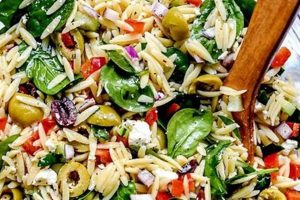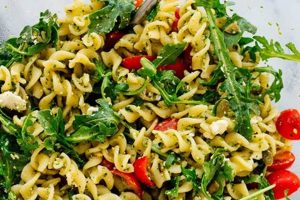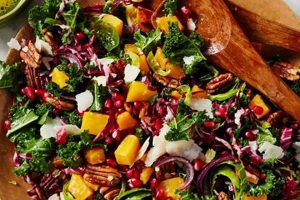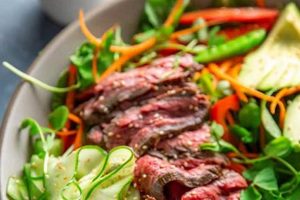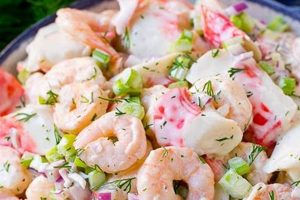A summer variation on the classic Italian appetizer, this dish typically features fresh, ripe peaches alongside mozzarella cheese, basil, and a balsamic glaze. The sweetness of the peaches complements the creamy mozzarella and peppery basil, creating a refreshing and flavorful salad.
This simple yet elegant dish offers a delightful balance of sweet, savory, and herbaceous flavors. The use of seasonal peaches elevates the traditional caprese salad, providing a unique twist. Its adaptability makes it suitable for a light lunch, appetizer, or side dish, contributing to its rising popularity in contemporary cuisine. Furthermore, the fresh ingredients offer a healthy and flavorful option.
Further exploration will cover variations on this dish, including ingredient substitutions and different balsamic glaze preparations, as well as tips for selecting the perfect peaches and achieving optimal presentation.
Tips for a Perfect Peach Caprese Salad
Achieving optimal flavor and presentation requires attention to detail. The following tips offer guidance for creating a truly exceptional salad.
Tip 1: Peach Selection: Opt for ripe, but firm peaches. Overripe peaches will have a mushy texture and may not hold their shape. Underripe peaches will lack the desired sweetness.
Tip 2: Mozzarella Quality: Fresh mozzarella, preferably made with buffalo milk (mozzarella di bufala), offers the best flavor and texture. Avoid pre-shredded mozzarella as it tends to be drier.
Tip 3: Basil Freshness: Use fresh basil leaves, preferably small and tender. Avoid large, older leaves which can have a bitter taste.
Tip 4: Balsamic Glaze Quality: A high-quality balsamic glaze is essential for balancing the flavors. Look for a thick, syrupy glaze with a rich, tangy flavor.
Tip 5: Slicing Technique: Slice the peaches and mozzarella into uniform thicknesses to ensure even distribution of flavors and an aesthetically pleasing presentation.
Tip 6: Arrangement: Arrange the peach slices, mozzarella, and basil leaves attractively on a platter or individual plates. Drizzle with balsamic glaze just before serving.
Tip 7: Seasoning: A light sprinkle of sea salt and freshly cracked black pepper can enhance the flavors of the salad.
Tip 8: Timing: This salad is best served fresh. Prepare and assemble the salad close to serving time to prevent the peaches from oxidizing and the mozzarella from becoming watery.
By following these guidelines, one can elevate this simple dish to a culinary masterpiece.
Considering these elements, the following section will explore variations and adaptations of this refreshing summer salad.
1. Fresh, Ripe Peaches
The foundation of a successful peach caprese salad rests upon the selection and utilization of fresh, ripe peaches. Peach quality significantly influences the overall flavor profile and textural experience of the dish. Understanding the nuances of peach selection is crucial for achieving the desired balance of sweetness, acidity, and firmness.
- Ripeness Indicators
Optimal ripeness is characterized by a fragrant aroma, a slight give to gentle pressure, and vibrant skin color. Avoiding overly firm or excessively soft peaches is essential. Overly firm peaches lack sweetness and juiciness, while overly soft peaches contribute to a mushy texture, compromising the structural integrity of the salad.
- Variety Selection
Different peach varieties offer unique flavor profiles and textures. Freestone peaches, which separate easily from the pit, are generally preferred for ease of preparation. Clingstone peaches, where the flesh adheres to the pit, can also be used but require more meticulous handling. Considering varietal characteristics allows for customization of the salad’s flavor profile.
- Storage and Handling
Proper storage and handling maintain peach quality. Storing ripe peaches in a cool, dry place or in the refrigerator extends their shelf life. Gentle handling minimizes bruising and preserves the delicate fruit. These practices contribute to optimal texture and flavor retention.
- Flavor Contribution
The sweetness of ripe peaches complements the creamy mozzarella and peppery basil, creating the characteristic flavor profile of the salad. The peach’s natural acidity balances the richness of the cheese, while its subtle sweetness enhances the overall flavor harmony. This interplay of flavors distinguishes the peach caprese salad from the traditional version.
By understanding the role of fresh, ripe peaches, one can elevate the peach caprese salad from a simple dish to a culinary experience. The careful selection, handling, and utilization of this key ingredient contribute significantly to the salads overall success, highlighting the importance of quality ingredients in achieving culinary excellence.
2. High-Quality Mozzarella
High-quality mozzarella plays a crucial role in a successful peach caprese salad. The mozzarella provides a creamy, milky counterpoint to the sweetness of the peaches and the peppery bite of basil. Its texture, ideally soft and yielding yet retaining some structure, contributes to the overall sensory experience. The interplay of flavors and textures relies heavily on the mozzarella’s quality. Using a subpar cheese can result in a bland, watery, or rubbery salad, diminishing the intended balance.
Fresh mozzarella, particularly mozzarella di bufala (made from water buffalo milk), offers the most desirable characteristics for this dish. Its rich, slightly tangy flavor and delicate texture complement the other ingredients beautifully. Lower-quality mozzarella, often made with cow’s milk and processed for longer shelf life, typically lacks the same depth of flavor and pleasant mouthfeel. For instance, using a pre-shredded, low-moisture mozzarella results in a drier, less flavorful salad, hindering the cohesive interplay of ingredients. Conversely, opting for fresh mozzarella elevates the dish, allowing the nuanced flavors of each component to shine.
Selecting high-quality mozzarella directly influences the success of a peach caprese salad. The cheese provides not only a textural element but also a crucial flavor component that balances and enhances the other ingredients. Understanding this relationship allows for informed ingredient choices, contributing to a more satisfying and flavorful culinary outcome. Investing in high-quality mozzarella, while potentially more expensive, ultimately elevates the final product, demonstrating the practical significance of ingredient selection in achieving culinary excellence.
3. Fresh Basil Leaves
Fresh basil leaves constitute an essential component of a successful peach caprese salad recipe. Basil contributes a distinct peppery, slightly minty aroma and flavor that balances the sweetness of ripe peaches and the richness of mozzarella. The interplay of these contrasting flavor profiles defines the characteristic taste of the salad. Dried basil, while convenient, lacks the vibrancy and complexity of fresh leaves, resulting in a muted, less nuanced flavor profile. This distinction underscores the importance of ingredient selection in achieving the desired culinary outcome.
Small, tender basil leaves are generally preferred, offering a more delicate texture and flavor compared to larger, mature leaves, which can sometimes develop a slightly bitter taste. Proper handling and storage of fresh basil are also crucial for maintaining optimal quality. Storing basil stems submerged in water at room temperature, similar to cut flowers, prolongs freshness. Alternatively, refrigerating basil leaves wrapped in a slightly damp paper towel helps preserve their vibrant flavor and texture. These practices ensure that the basil remains a key aromatic and flavor contributor to the salad.
Incorporating fresh basil leaves not only enhances the flavor profile but also adds visual appeal to the dish. The vibrant green hue of the basil contrasts beautifully with the creamy white mozzarella and the warm tones of ripe peaches, creating an aesthetically pleasing presentation. This combination of aromatic, flavorful, and visual elements elevates the peach caprese salad from a simple combination of ingredients to a more complex and satisfying culinary experience. Understanding the contribution of fresh basil and employing appropriate handling techniques allows one to maximize its impact on the final product, demonstrating the practical implications of ingredient quality and preparation in achieving culinary excellence.
4. Balsamic Glaze
Balsamic glaze provides a crucial element of acidity and sweetness to balance the other ingredients within a peach caprese salad recipe. It contributes a depth of flavor that elevates the dish beyond a simple combination of ingredients. The quality and type of balsamic glaze significantly influence the overall flavor profile and perceived complexity of the salad.
- Flavor Profile
Balsamic glaze contributes a complex, tangy sweetness that contrasts with the fresh peaches, creamy mozzarella, and peppery basil. A high-quality balsamic glaze offers notes of fig, molasses, or even cherry, adding depth and richness to the salad. A poorly made glaze can taste overly acidic or cloyingly sweet, disrupting the delicate balance of flavors.
- Consistency and Texture
The consistency of the balsamic glaze affects its visual appeal and how it interacts with the other ingredients. A thick, syrupy glaze adheres well to the components of the salad, providing a pleasing visual element and ensuring even distribution of flavor. A thin, watery glaze tends to pool at the bottom of the dish, resulting in an uneven flavor experience.
- Quality and Ingredients
Traditional balsamic glaze is made from cooked grape must aged in wooden barrels for extended periods. Lower-quality versions often contain added sugars, thickeners, and artificial colorings, which can negatively impact the flavor profile. Choosing a high-quality balsamic glaze, ideally one made with minimal added ingredients, ensures a more authentic and nuanced flavor.
- Application and Presentation
The manner in which balsamic glaze is applied to the salad affects both the visual presentation and the distribution of flavor. Drizzling the glaze artistically over the arranged ingredients creates an appealing visual contrast and prevents the salad from becoming soggy. Alternatively, a light brush of glaze can be applied to each individual component before assembly, offering a more subtle flavor integration.
The selection and application of balsamic glaze significantly influence the overall success of a peach caprese salad recipe. Understanding the various facets of balsamic glaze, including its flavor profile, consistency, quality, and application technique, allows for informed decision-making and contributes to a more refined and balanced culinary creation. Choosing a high-quality balsamic glaze and applying it thoughtfully elevates the salad, demonstrating the practical implications of ingredient selection and technique in achieving culinary excellence.
5. Proper Preparation
Proper preparation techniques are essential for maximizing the flavor and visual appeal of a peach caprese salad. Careful attention to detail in each stage, from ingredient handling to final assembly, ensures a harmonious blend of flavors, textures, and colors, elevating the dish from simple to exceptional. Overlooking these crucial steps can compromise the salad’s overall quality, resulting in a less satisfying culinary experience.
- Ingredient Handling
Gentle handling of ingredients preserves their freshness and structural integrity. Washing and drying the peaches and basil leaves carefully minimizes bruising and wilting. Storing the mozzarella in its liquid until ready to use prevents drying and maintains its creamy texture. These practices safeguard the quality of each individual component, laying the foundation for a successful final product.
- Slicing Techniques
Uniform slicing of the peaches and mozzarella ensures even distribution of flavors and contributes to an aesthetically pleasing presentation. Consistent slice thickness allows for balanced flavor integration and prevents certain ingredients from dominating the palate. Furthermore, uniform slices create a visually appealing arrangement, enhancing the overall dining experience.
- Timing and Assembly
Timely assembly is crucial for preventing oxidation and maintaining optimal ingredient freshness. Preparing the salad close to serving time ensures that the peaches retain their vibrant color and flavor, while the mozzarella remains creamy and does not release excess moisture. Delayed assembly can result in a less appealing and flavorful salad.
- Arrangement and Presentation
Thoughtful arrangement of the ingredients elevates the visual appeal of the salad. Alternating slices of peaches, mozzarella, and basil leaves creates a visually engaging pattern. Drizzling the balsamic glaze artistically over the arranged ingredients adds a final touch of elegance, enhancing the overall presentation and stimulating the appetite.
Proper preparation techniques play a pivotal role in the success of a peach caprese salad recipe. Careful attention to ingredient handling, slicing techniques, timing, and presentation ensures optimal flavor, texture, and visual appeal. These practices highlight the importance of culinary technique in maximizing the potential of fresh, high-quality ingredients, resulting in a dish that is both visually appealing and gastronomically satisfying.
Frequently Asked Questions
This section addresses common inquiries regarding the preparation and enjoyment of peach caprese salad.
Question 1: Can other cheeses be substituted for mozzarella?
While mozzarella is traditional, burrata or fresh ricotta offer similar creamy textures and mild flavors that complement the peaches and basil. Feta cheese provides a saltier, tangier option.
Question 2: What can be used in place of basil?
Mint offers a refreshing alternative, while other herbs like tarragon or chives provide more savory notes. Arugula can also be incorporated for a peppery bite.
Question 3: How long can the salad be stored?
For optimal flavor and texture, it is recommended to consume the salad immediately after preparation. Storage beyond two hours may lead to oxidation of the peaches and a watery consistency.
Question 4: Can the salad be prepared in advance?
While not ideal, components can be prepared separately in advance. Store sliced peaches in an airtight container with a squeeze of lemon juice to prevent browning. Assemble the salad just before serving to maintain freshness.
Question 5: What are suitable accompaniments for peach caprese salad?
Crusty bread, grilled chicken or fish, and light pasta dishes complement the salad well. A simple vinaigrette can also be served alongside.
Question 6: How can one ensure optimal peach ripeness?
Select peaches with a fragrant aroma and a gentle give to pressure. Avoid overly firm or soft peaches. Properly ripened peaches contribute optimal sweetness and texture to the salad.
Addressing these common inquiries provides a comprehensive understanding of the nuances involved in preparing and enjoying a successful peach caprese salad.
The following section will offer a curated collection of variations on the classic recipe, expanding culinary possibilities.
Peach Caprese Salad Recipe
Exploration of the peach caprese salad recipe reveals a dish characterized by a harmonious balance of flavors and textures. Careful selection of ripe peaches, high-quality mozzarella, fresh basil, and a nuanced balsamic glaze contributes significantly to the overall culinary experience. Proper preparation techniques, including ingredient handling, slicing, timing, and presentation, further enhance the dish, maximizing its visual appeal and gastronomic potential. Addressing common inquiries regarding ingredient substitutions, storage, and accompaniments provides a comprehensive understanding of the dish’s versatility and adaptability.
The peach caprese salad recipe represents a compelling example of culinary innovation built upon a foundation of classic principles. Its reliance on fresh, seasonal ingredients and straightforward preparation underscores the enduring appeal of simplicity in gastronomy. Continued exploration of variations and adaptations promises further evolution of this refreshing and elegant dish, solidifying its position within the contemporary culinary landscape.

